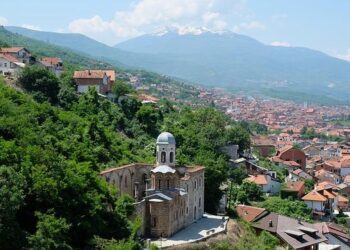In an unprecedented international effort, the Kentucky National Guard has played a critical role in combating a massive wildfire threatening the historic Visoki DeÄŤani Monastery in Kosovo. As flames engulfed the surrounding forested area, Guard members joined local firefighters and international teams to protect this UNESCO World Heritage site, demonstrating the growing scope of the National Guard’s emergency response capabilities beyond U.S. borders. This collaboration highlights the vital importance of shared expertise and resources in preserving cultural landmarks and safeguarding communities from natural disasters worldwide.
Kentucky National Guard Mobilizes to Combat Devastating Wildfire at Kosovo Monastery
In an unprecedented call to international aid, the Kentucky National Guard swiftly deployed personnel and specialized equipment to assist local authorities in combating a destructive wildfire threatening the centuries-old Kosovo Monastery. Known for its cultural and religious significance, the historic site faced severe fire damage risks due to a sudden surge in dry conditions and strong winds. The Guard’s rapid response included aerial water drops, ground firefighting teams, and logistical support, marking a significant collaboration between U.S. forces and Kosovo’s emergency services.
Key elements of the Kentucky National Guard’s deployment included:
- Helicopter water drops: Utilizing UH-60 Black Hawk helicopters equipped with Bambi buckets to suppress flames swiftly.
- Ground firefighting units: Teams trained in forest fire containment establishing control lines and protecting shrine buildings.
- Coordination with local authorities: Joint command center established to streamline emergency operations and share intelligence.
| Deployment Detail | Duration | Equipment Used |
|---|---|---|
| Aerial Fire Suppression | 5 Days | UH-60 Black Hawk, Bambi Buckets |
| Ground Operations | 7 Days | Firefighting Engines, Hand Tools |
| Support & Logistics | Throughout Deployment | Command Vehicles, Communications Gear |
Strategic Coordination Enhances Firefighting Efforts Amidst Challenging Terrain
Facing the rugged and densely forested landscape surrounding the historic Kosovo Monastery, coordination among firefighting units proved critical. The Kentucky National Guard seamlessly integrated with local fire departments and international experts to establish a unified command structure. This approach allowed for optimized resource deployment, rapid communication, and strategic firefighting efforts that overcame natural obstacles such as steep slopes and limited access points.
Key factors in operational success included:
- Utilization of aerial reconnaissance to pinpoint fire hotspots swiftly
- Deployment of specialized terrain vehicles adapted for rough environments
- Implementation of real-time weather monitoring for proactive decision-making
- Daily briefings to align ground, air, and support teams on evolving fire dynamics
| Unit | Role | Equipment |
|---|---|---|
| Kentucky National Guard | Fire Suppression & Logistics | Water tankers, Bulldozers |
| Local Fire Department | Fire Containment & Evacuation | Fire Engines, Protective Gear |
| International Experts | Strategy & Aerial Surveillance | Drones, Helicopters |
Recommendations for International Collaboration in Protecting Cultural Heritage from Wildfires
Effective protection of cultural heritage sites from wildfires requires a coordinated international approach that leverages the strengths of diverse agencies and expertise. Countries facing similar threats should establish early-warning systems and create joint task forces that include wildfire specialists, cultural preservationists, and military support units. Sharing advanced firefighting technology, such as aerial surveillance drones and fire-retardant materials, can significantly improve response times and containment efforts. Additionally, standardized training programs for emergency responders will foster smoother collaboration during crises, ensuring that every team member understands the unique challenges posed by heritage structures.
Collaboration must also extend beyond emergency response with the implementation of unified protocols for risk assessment, documentation, and restoration of endangered sites. Building a global database that tracks vulnerable cultural landmarks and their risk levels can guide pre-emptive planning and resource allocation. The table below highlights key actions and stakeholders that should be involved in a cohesive international wildfire protection strategy:
| Action | Primary Stakeholders | Expected Impact |
|---|---|---|
| Shared Fire Monitoring Systems | Governments, Meteorological Agencies | Faster Detection & Response |
| Joint Training Exercises | Military Units, Firefighters, Conservators | Improved Coordination |
| Resource Sharing Agreements | International NGOs, Local Authorities | Optimized Equipment Usage |
| Global Heritage Risk Database | UNESCO, Cultural Institutions | Targeted Prevention Strategies |
The Way Forward
As the efforts to contain the wildfire near the historic Kosovo monastery continue, the Kentucky National Guard’s swift deployment underscores the vital role of National Guard units in responding to international emergencies. Their collaboration with local authorities not only highlights the importance of cross-border assistance in disaster relief but also reinforces a commitment to preserving cultural heritage sites under threat. Updates on the containment progress and ongoing support will be provided as the situation develops.















